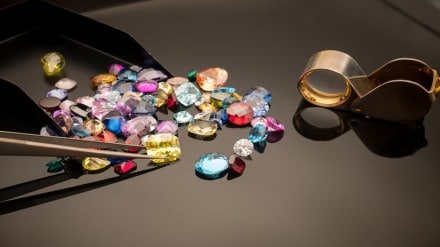By Krishna Barot | Mukesh Jagota
Being at once import-intensive and export-oriented, the gems and jewellery industry can withstand the current fall of the rupee, but have serious concerns about the continued sluggishness in demand from key export markets. In the major industry clusters, capacity utilisation has plummeted to abysmally low levels.
The depreciation of the rupee will not add to the topline or bottomline of the gems and jewellery exporters, as over 95% of inputs are imported. In the domestic market, however, prices of precious metals and stones will increase, which may be lucrative for the units.
In April-November, exports of the gems and jewellery sector, which have employment potential of 5 million in times of brisk business, fell 10.1% to $19.2 billion.
Vipul Shah, chairman of Gems and Jewellery Export Promotion Council, said: “We are hoping that 2025 may bring improved prospects for the sector as polished diamond prices have stabilised and showing some signs of recovery. However, the demand is still subdued in the key export markets, with buyers focusing more on jewellery.”
The US and European markets for jewellery are holding up and there has been a return of demand in West Asia, he noted.
The demand in east Asia, however, has been tepid. With the stimulus that China is about to unveil, demand from the neighbouring country is expected to grow strongly as it is low on inventory. An easing of geopolitical risks with the hopes of a resolution to the Russia-Ukraine conflict are what Indian gems and jewellery exporters pin hopes on.
Gross exports of cut & polished diamonds in November 2024 amounted to $666 million – a decline of 39.8% in comparison to the year-ago month. “In response to this, many diamond companies are cutting down production and there are still several factories that haven’t been operating at full capacity since Diwali,” Shah said.
In Surat, approximately 30% of 15,000 diamond cutting and processing units have not been reopened since Diwali.
Chintan Sanghvi, a senior executive at Kiran Gems, said that lower production among manufacturers is an effective step in combating import costs. “As many factories are operating at 75% or even less of their original capacity, the imports of raw materials have also decreased,” he said. Sanghvi estimates a 30% year-on-year decrease in imports of rough diamonds. He noted that while the export markets will take time to stabilise, domestic sales are gradually recovering due to the holiday season. Domestic market currently accounts for 33% of the sales, he added.
The sector’s struggles are at a time when lab-grown diamonds (LGDs) have begun permeating the market. While there is ample discourse on whether LGDs will eventually replace natural diamonds, Shah differs. “LGDs are not a competition to natural diamonds,” Sanghvi said. “These are two sets of products catering to a different set of consumers. Lab-grown diamonds have been an entry point for consumers who always aspired to own a diamond. It is still at its nascent stage, getting positioned as a product of adornment.”
Colin Shah, managing director at Kama Jewelry, said: “While LGDs are here to stay, they cater to an entirely different consumer base. Predominantly, you will find people buying LGDs as fashion accessories, as they can be bought for as little as 5% of the price of an equivalent diamond. However, for weddings and similar events, people may yet opt for natural diamonds.” As of November 2024, the gross exports for polished LGDs were $62.88 million, a 42.4% decline over year.
